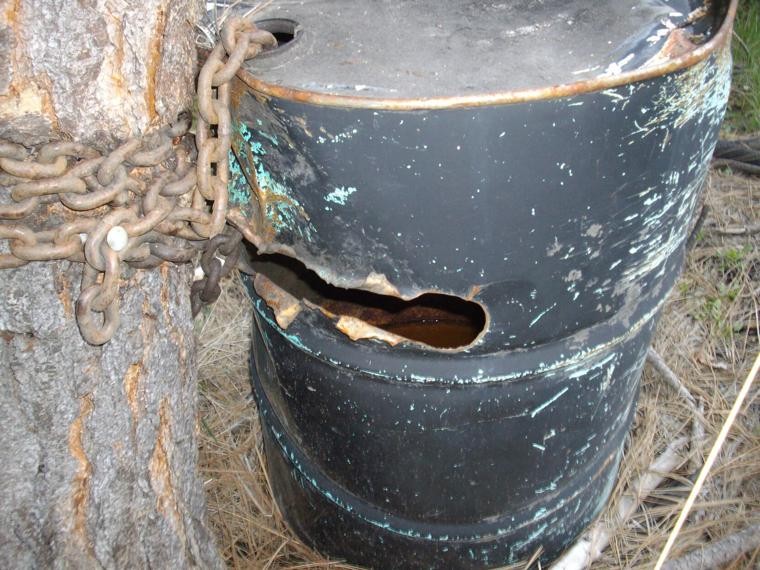I struggled deciding whether to write about bear hunting this week or mushroom hunting since they are both time-sensitive topics. I think what I’ll do is to write about “baiting for bears and scouting” this week, mushroom hunting next week and then follow up with another bear article the third week.
Unless something else more fun pops up in the meantime!
So, let’s say you want to go bear hunting this spring. I’ll give you a few pointers to help you out.
Twenty years ago I’d be up bear baiting and bear hunting on opening day, which is April 15 in most units. But really, bears aren’t in the groove, eating good until later in the season in most units.
Think about it for a minute. They’ve been hibernating and fasting for nearly six months. If you’ve ever fasted then you know that day one after the fast you might not feel like eating a bowl of salsa and chips along with a plateful of spicy enchiladas! Your stomach is a little off kilter. Same with bears. They come out and eat grass/flower tops at first and pass their plug. Which basically corks them up for the hibernation period.
As a general rule, right when they come out of hibernation you’ll see them at the snowline, right? That’s because the vegetation is springing up when the snow melts and is tender. When I say at the snowline, I don’t mean within two feet of the snowline. But as the snow melts and tender green grass pops up, they do follow that. I don’t know their scientific name but they go along eating the yellow flower tops as the snowline melts and moves uphill.
The first thing we have to do is determine where you’re going to bait. You don’t want to waste time baiting where there’s no bears, do you? Think back to last year where you were seeing bear signs. Or go out scouting now. Bears eat high-fiber diets so they leave a lot of signs. Find where there’s a lot of signs or a dark secluded canyon and hit it.
You don’t want to bait too close to a road/trail or hound hunters can drive by and run your bears after you’ve done all of the hard work to get them coming in. You also don’t want to park your truck out in the open where everyone passing by knows that you’re baiting in that area.
You don’t want bears free feeding. Chain a barrel to a tree so they can’t drag it away. Cut a hole about 10-inches in diameter about two-thirds of the way up. This way bears will have to stick their paws in the hole and dig out bait. If you just dump it in a pile they can come in, gorge and leave. You want to slow them down and make them hang around longer. Can you just dump it on the ground though? Yes, it’s just not the preferred method. You’d be surprised at how much bait the ravens can carry off. And barrels also prevent foxes, coyotes and wolves from eating your bait.
A barrel also protects your bait from the rain so it doesn’t mold or rot as fast. A snap top lid is nice. That way you can remove the top, fill the barrel and then snap the top back on. If you bait correctly and get four to six bears coming in, they can put down the chow!
Their stomachs are somewhat queasy at first when they come out of hibernation. I have hauled literally tens of thousands of pounds of meat up to the mountains for bear bait, but in early spring, meat is not necessarily the best bait.
In late summer when bears are binge feeding, storing up fat for the winter, they will eat virtually anything. But given a choice, I still say that they can be selective. One time I laid out a bushel basket of fruit, melons, peaches, vegetables, cereal, donuts, etc. A bear went through and picked out what he preferred. So given a choice I am convinced that they have preferences. Years ago I’d buy loads of old bread and donuts from a day-old bread company. I’d dump out piles and they’d dig through and eat all of the Hostess Twinkies. But if nothing else is available, yes, they will eat anything. Make sense?
A lot of times what bait you use is really determined by what is available to you. If available, small bait is nice. Like let’s say dog food. That means they have to stick their paw in and scoop up food. They can’t gorge and run. If you put out big chunks of meat they’ll come in and grab a piece and take it off in the brush and only afford a fast shot.
I love baiting because it allows you to study a bear. You have time to ensure that it’s not a sow with cubs. You have time to make sure it isn’t rubbed bad. Is it the color phase that you want? Is it big enough?
There’s a misconception out there in the bunny hugging world that all you have to do is to hang a donut on a limb out in the forest and Boo-Boo and all of his buddies will come stampeding in. It’s not quite that simple. It takes a lot of hard work and strategy. And after they start hitting your bait you need to refill it every two to three days.
Good luck!
Tom Claycomb lives in Idaho and has outdoors columns in newspapers in Alaska, Idaho, Utah, Nevada, Colorado and Louisiana. He also writes for various outdoors magazines and teaches outdoors seminars at stores like Cabela’s, Sportsman’s Warehouse and Bass Pro Shop. He can be reached via email at smileya7@aol.com.



